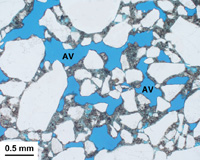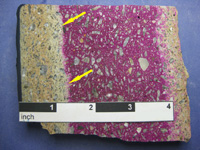


The mortar shown here is a well cured Type N repointing mortar. However, RILEM tube tests performed after efflorescence appeared revealed an unacceptable degree of permeability. Petrographic study of the cement paste indicated a normal capillary porosity. However, a coarser irregular porosity created an interconnected network of relatively large air-voids (AV). It was determined that inadequate consolidation of the deep repointing left the masonry subject to deep water infiltration during rainstorms. This water leached calcium from the cured binder transporting salts to the wall surface during evaporation.
A cast stone core is sliced longitudinally and treated with a pH indicator. The pink areas are uncarbonated and retain the original porosity structure of the masonry as cast. Near the surface, the uncolored portions are fully carbonated and the deep level of carbonation is caused by the higher original water to cement ratio used in the wet cast process. However, the carbonation causes a densification of the cement paste locally. In this case, RILEM tests can be misleading suggesting a lower porosity. However, moisture traveling along disbonded joint surfaces can reach the more porous interior resulting in freeze-thaw failure. It is not uncommon to see deep cracking in such cast stone with “shell spalls” of the case-hardened carbonated layer once deeper invisible freeze-thaw cracking has progressed too far. Such surface to interior variations in porosity should be considered when performing laboratory absorption tests.
Properties of the pore structure can be investigated through a variety of methods. In the field, RILEM tube testing is the most common and economical method of determining the approximate water permeability of any component on the building envelope. In the laboratory, absorption tests quantify the gross porosity of the material while capillary uptake or vapor transmission tests can be used to investigate the permeability or transport properties as a function of time. Neither of these actually determines the size distribution of the void spaces and mercury intrusion porosimetry is a high-tech tool for this purpose. Though petrography is a qualitative tool, it may be used to estimate this size distribution in a less precise way. However, it has the benefit of being able to look at the permeability structure qualitatively in full cross section rather than in bulk. It also may reveal the origin of the porosity and causes for unexpectedly high permeability.

